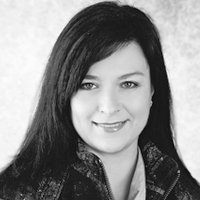Question
For pediatric patients, what are the most important factors and considerations for selecting, fitting and using bone conduction technology, such as Baha®?
Answer
If the baby has atresia/microtia and traditional amplification is not an option, our clinic follows the Joint Commission on Infant Hearing (JCIH) 1-3-6 Guidelines when it comes to fitting children with Baha on Softband. These babies are the easiest and most straight-forward cases, especially with bilateral atresia/microtia. The cause of the hearing loss is visible, which helps with family motivation, and we fit the bone conduction scores instead of a potential fluctuating air conduction score. For these babies it is also easy to apply the JCIH new suggestions of 1-2-3 Guidelines. In cases of bilateral losses, bilateral fittings should be fit bilaterally.
In cases of unilateral atresia/microtia or SSD, when-to-fit is a little more complex. In order to put a Baha processor behind and/or near the affected ear to obtain the best microphone placement, it creates a bit of an issue with babies and head control. My recommendation with these patients is to obtain good, reliable diagnostic results and proceed with the Baha Softband order. Wear-time may be limited until the baby has established good head control, and full-time wear-time may therefore be delayed. However, parents can use tummy time and other times when the baby is upright to begin using the Baha on a Softband. For most families, although a proper wear-time goal might not be obtained until 7-9 months of age when the baby spends a majority of their day sitting up, earlier use can still be beneficial.
When choosing between traditional air conduction aids and bone conduction, first and foremost anatomy plays the biggest part. If the ear can support an earmold and hearing aid, then it should at least be discussed with the family. I often list out the advantages of each solution in the initial diagnosis or fitting appointment. Some of the important things to discuss are if there is fluctuating air conduction due to middle ear status, such as in many patients with Down syndrome. Another notable thought is sound quality, do we overdrive an ear with a conductive loss and a traditional hearing aid? Or do we use the good bone conduction with a Baha for a better sound quality?
When comparing traditional CROS to Baha for SSD, age is a very important factor. Fitting children with unilateral losses with a CROS should be given great consideration. As the AAA Pediatric Amplification Guidelines point out, attention to the child’s age and the ability to control their environment must be considered. There is currently a very limited set of data to inform audiologists about this decision. As the Baha doesn’t ‘amplify’ by air conduction, I feel this is a safer option for young children with SSD.
Overall, there are many factors to consider, and open communication with the parents is key to ensure best outcomes for the child.
© Cochlear Limited 2020. All rights reserved. Hear now. And always and other trademarks and registered trademarks are the property of Cochlear Limited or Cochlear Bone Anchored Solutions AB. The names of actual companies and products mentioned herein may be the trademarks of their respective owners.
Views expressed are those of the individual. Consult your hearing health provider to determine if you are a candidate for Cochlear technology. Please seek advice from your health professional about treatments for hearing loss. Outcomes may vary, and your health professional will advise you about the factors which could affect your outcome. Always read the instructions for use. Not all products are available in all countries. Please contact your local Cochlear representative for product information.
In the United States and Canada, the placement of a bone-anchored implant is contraindicated in children below the age of 5.

